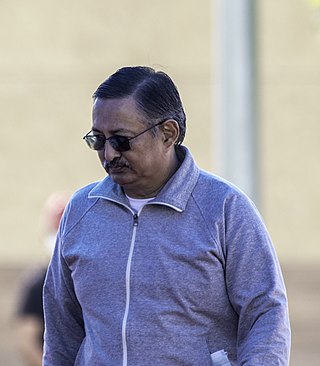Related Research Articles

The Lhotshampa or Lhotsampa people are a heterogeneous Bhutanese people of Nepalese descent. "Lhotshampa", which means "southern borderlanders" in Dzongkha, began to be used by the Bhutanese state in the second half of the twentieth century to refer to the population of Nepali origin in the south of the country. After being displaced as a result of the state-run ethnic cleansing and living in refugee camps in eastern parts of Nepal, starting in 2007 most of the Bhutanese Refugees were resettled to various countries, such as the United States, Canada, Australia, the United Kingdom, and other European countries. As of 2021 the number of Lhotshampa in Nepal is significantly lower than that in the United States and other countries where they have resettled. People of Nepalese origin started to settle in uninhabited areas of southern Bhutan in the 19th century.

Bhutan, officially the Kingdom of Bhutan, is a landlocked South Asian country, which is situated in the Eastern Himalayas, between China in the north and India in the south. A mountainous country, Bhutan is known locally as "Druk Yul" or "Land of the Thunder Dragon", a name reflecting the cultural heritage of the country. The exonym Bhutan likely derives from the Prakrit hybrid word Bhŏṭṭaṃta, a name referring to its geographical proximity to Tibet (Bhŏṭṭa). Nepal and Bangladesh are located near Bhutan but do not share a border with it. The country has a population of over 727,145 and territory of 38,394 square kilometres (14,824 sq mi) and ranks 133rd in land area and 160th in population. Bhutan is a constitutional monarchy with a king as the head of state and a prime minister as the head of government. Vajrayana Buddhism is the state religion and the Je Khenpo is the head of state religion.

Bhutanese refugees are Lhotshampas ("southerners"), a group of Nepali language-speaking Bhutanese people. These refugees registered in refugee camps in eastern Nepal during the 1990s as Bhutanese citizens who fled or were deported from Bhutan during the protest against the Bhutanese government by some of the Lhotshampas demanding human rights and democracy in Bhutan. As Nepal and Bhutan have yet to implement an agreement on repatriation, most Bhutanese refugees have since resettled to North America, Oceania and Europe under the auspices of the Office of the United Nations High Commissioner for Refugees. Many Lhotshampa also migrated to areas of West Bengal and Assam in India independently of the UNHCR.
Immigration to Bhutan has an extensive history and has become one of the country's most contentious social, political, and legal issues. Since the twentieth century, Bhutanese immigration and citizenship laws have been promulgated as acts of the royal government, often by decree of the Druk Gyalpo on advice of the rest of government. Immigration policy and procedure are implemented by the Lhengye Zhungtshog Ministry of Home and Cultural Affairs, Department of Immigration. Bhutan's first modern laws regarding immigration and citizenship were the Bhutanese Citizenship Act 1958 and subsequent amendments in 1977. The 1958 Act was superseded by the Bhutanese Citizenship Act 1985, which was then supplemented by a further Immigration Act in 2007. The Constitution of 2008 included some changes in Bhutan's immigration laws, policy, and procedure, however prior law not inconsistent with the 2008 Constitution remained intact. Bhutan's modern citizenship laws and policies reinforce the institution of the Bhutanese monarchy, require familiarity and adherence to Ngalop social norms, and reflect the social impact of the most recent immigrant groups.
Numerous ethnic groups inhabit Bhutan, but the Ngalop people who speak the Dzongkha language constitute a majority of the Bhutanese population. The Bhutanese are of four main ethnic groups, which themselves are not necessarily exclusive - the politically and culturally dominant Ngalop of western and northern Bhutan, the Sharchop of eastern Bhutan, the Lhotshampa concentrated in southern Bhutan, and Bhutanese tribal and aboriginal peoples living in villages scattered throughout Bhutan.

Hinduism is the second largest religious affiliation in Bhutan, covering about 22.6% of the population, according to the Pew Research Center 2010. It is followed mainly by the ethnic Lhotshampa. The Shaivite, Vaishnavite, Shakta, Ganapathi, Puranic, and Vedic schools are represented among Hindus. Hindu temples exist in southern Bhutan, and Hindus practice their religion in small- to medium-sized groups. About 75% of the population of Bhutan are Buddhist.
Tek Nath Rizal is one of the top leaders of Bhutanese refugees, and a political and human rights activist in Bhutan.

Bal Krishna Khand is a former, Nepalese politician, former Home Minister of Nepal and a convict of the Bhutanese refugees scam recently unveiled. Khand is a central working committee member of the Nepali Congress party. Khand also served as the Defense Minister of Nepal under the Second Dahal cabinet.
Human rights in Bhutan are those outlined in Article 7 of its Constitution. The Royal Government of Bhutan has affirmed its commitment to the "enjoyment of all human rights" as integral to the achievement of 'gross national happiness' (GNH); the unique principle which Bhutan strives for, as opposed to fiscally based measures such as GDP.
Nepalese Americans are Americans of Nepalese ancestry. Immigration from Nepal to the United States began in the 20th century, and many have been able to establish themselves as American nationals. The history of immigration from Nepal to America is more recent in comparison to other South Asian ethnic groups. Major community groups of Nepali Americans consists of Khas, followed by minority Newars, Tharus, Tamangs, Gurungs, Limbus, Rais, Magar, Madhesis, Lhotshampas, Sherpas, and others, as of American Nepalese Convention Survey of 2018.

Bhutan–Nepal relations refer to the bilateral relations between the Bhutan and Nepal. Relations were formally established in 1983. The two Himalayan countries are both landlocked, separated only by the Indian State of Sikkim. Both countries are bordered by India and the People's Republic of China. However, the current state of relations remains strained owing to the Bhutanese refugee crisis.
Nepalese Australians or Nepali Australians are the Citizens/Permanent Residents in Australia whose ethnic origins lie fully or partially in Nepal. Nepalese started to settle in Australia from the 1960s.
Nepal is home to 40,490 refugees officially recognized by the United Nations High Commissioner for Refugees (UNHCR). Indian, Tibetan and Bhutanese refugees account for a large majority of Nepal’s refugee population.
Nepalese in the Netherlands consists of immigrants, expatriates and international students from Nepal to the Netherlands as well as Dutch people of Nepalese origin. As of 2010, statistics of the Dutch Centraal Bureau voor de Statistiek shows that there are about 1,505 people of Nepalese origin living in the country.
Bhutanese Americans are Americans of Bhutanese descent. According to the 2010 census there are 19,439 Americans of Bhutanese descent. However, many Nepali-Bhutanese came to the U.S. via Nepal as political refugees from that country and are registered as Nepali Americans; often leading to the actual numbers of Bhutanese Americans being underreported. More than 92,323 Bhutanese Nepalis have been resettled in the United States, with the largest single community being approximately 27,000 in Columbus, Ohio.
Bhutanese Nepali literature refers to the literary works in the Nepali language by Bhutanese people. This started from 1962 with the publishing of Kuensel.

Nepali is an Indo-Aryan language native to the Himalayas region of South Asia. It is the official, and most widely spoken, language of Nepal, where it also serves as a lingua franca. Nepali has official status in the Indian state of Sikkim and in the Gorkhaland Territorial Administration of West Bengal. It is spoken by about a quarter of Bhutan's population. Nepali also has a significant number of speakers in the states of Arunachal Pradesh, Assam, Himachal Pradesh, Manipur, Meghalaya, Mizoram and Uttarakhand. In Myanmar it is spoken by the Burmese Gurkhas. The Nepali diaspora in the Middle East, Brunei, Australia and worldwide also use the language. Nepali is spoken by approximately 16 million native speakers and another 9 million as a second language.
Anti-Tibetan sentiment refers to fear, dislike, hostility, and racism towards Tibetan people or anything related to Tibetan culture in general. Anti-Tibetan sentiment has been present in various regions of Bhutan, China, India, and Nepal at various points in time. Anti-Tibetan sentiment in South Asia is due to the presence of Tibetan immigrants in those countries. Anti-Tibetan sentiment in China has been fueled by Tibet's historical annexation by China on multiple occasions throughout the centuries. This annexation led to ongoing tensions between Tibetans and Han Chinese, with Tibet currently being under the administration of the People's Republic of China.

Ethnic cleansing in Bhutan refers to a series of violences to remove the Lhotshampa, or ethnic Nepalis, from Bhutan. Inter-ethnic tensions in Bhutan have resulted in the flight of many Lhotshampa to Nepal, many of whom have been expelled by the Bhutanese military. By 1996, over 100,000 Bhutanese refugees were living in refugee camps in Nepal. Many have since resettled in Western nations.
British Bhutanese are people of Bhutanese ancestry who are citizens of the United Kingdom or resident in the country. This includes people born in the UK who are of Bhutanese descent, and Bhutan-born people who have migrated to the UK.
References
- ↑ "Nepalese ethnic group". Stats NZ.
- ↑ "New Zealand - the youngest country - Welcome to New Nepal". Archived from the original on 2009-08-14. Retrieved 2011-01-12.
- ↑ US largest new home for Bhutanese refugees
- ↑ Nepal Festival in Auckland 2009